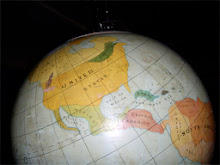The Unreality of Overstreet's Pyschological Reality
(from notebook, July 4 2006)
Upon reading a few pages of The Enduring Quest by Overstreet:
Overstreet identifies an invisible reality behind physical reality. This invisible reality, or psychological reality, consists of the "whys" associated with physical things. For example, "why" did an author write a book. "Why" did an engineer build a bridge. "Why did the artist utilize those colors. The answers consist of needs, frustrations, triumphs-feelings/mind-behind all things. These answers could fill books, granting the ordinary much glory. Seen in this light, Overstreet seems to bestow upon physical reality significance and meaning, as well as a depth of information not unlike the information shared by an art historian critiquing a work of art.
Does a work of art literally possess both the emotion and reason which occupied the artist while creating it? No. But in a sense it communicates it spiritually, if you will.
A psychologist might explain the effects of a piece of art by referring to both instinctual and learned emotion which are communicated through works of art due to the commonality of our emotional natures. Yes, "spiritually" is a misleading word, just as Overstreets concept of this invisible reality is misleading. It is a human psychological construction, just as so much of our "reality" is. To a great extent, we depend on similar constructions for our continued happiness. Overstreet chooses to infuse something abstract or mystical into his conception of the mind and reality. He creates a reality out of simple correlating facts; the learned, natural emotions attached to those facts; as well as an unreasonable faith in purpose/meaning.
Upon reading a few pages of The Enduring Quest by Overstreet:
Overstreet identifies an invisible reality behind physical reality. This invisible reality, or psychological reality, consists of the "whys" associated with physical things. For example, "why" did an author write a book. "Why" did an engineer build a bridge. "Why did the artist utilize those colors. The answers consist of needs, frustrations, triumphs-feelings/mind-behind all things. These answers could fill books, granting the ordinary much glory. Seen in this light, Overstreet seems to bestow upon physical reality significance and meaning, as well as a depth of information not unlike the information shared by an art historian critiquing a work of art.
Does a work of art literally possess both the emotion and reason which occupied the artist while creating it? No. But in a sense it communicates it spiritually, if you will.
A psychologist might explain the effects of a piece of art by referring to both instinctual and learned emotion which are communicated through works of art due to the commonality of our emotional natures. Yes, "spiritually" is a misleading word, just as Overstreets concept of this invisible reality is misleading. It is a human psychological construction, just as so much of our "reality" is. To a great extent, we depend on similar constructions for our continued happiness. Overstreet chooses to infuse something abstract or mystical into his conception of the mind and reality. He creates a reality out of simple correlating facts; the learned, natural emotions attached to those facts; as well as an unreasonable faith in purpose/meaning.


0 Comments:
Post a Comment
Subscribe to Post Comments [Atom]
<< Home